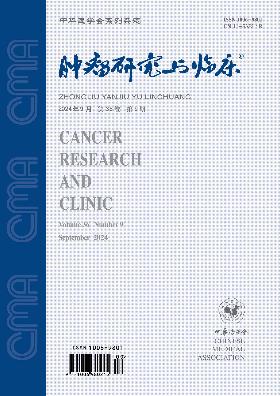Clinical observation of Brucea javanica oil emulsion injection combined with S-1 for treatment of elderly patients with advanced gastric cancer
Q4 Medicine
引用次数: 0
Abstract
Objective To observe the efficacy and safety of Brucea javanica oil injection combined with S-1 in the treatment of elderly patients with advanced gastric cancer. Methods The clinical data of 62 elderly patients with advanced gastric cancer who were admitted to Shanxi Provincial Cancer Hospital from May 2017 to May 2018 were retrospectively analyzed. Thirty-one patients in the control group treated with S-1 alone, and 31 patients in the observation group treated with S-1 combined with Brucea oil emulsion injection. The clinical efficacy, adverse reactions, immune function and quality of life of the two groups were compared. Results The total effective rates of the observation group and the control group were 70.97% (22/31) and 48.39% (15/31), respectively, and the difference was statistically significant (χ 2 = 11.889, P 0.05). The Karnofsky scores of the observation group and the control group after treatment were (92±4) points and (86±3) points, respectively, and the difference was statistically significant (t = -2.075, P = 0.042). The serum levels of interleukin-2 (IL-2) and interferon-γ in the observation group after treatment were (38±4) ng/L and (51±4) ng/L, and the levels in the control group were (31±3) ng/L and (40±4) ng/L, respectively, and the differences were statistically significant (t values were -2.097 and -2.293, both P < 0.05), and the serum levels of IL-4, IL-6 and IL-10 in the observation group after treatment were (42±5) ng/L, (34±4) ng/L and (22±2) ng/L, and the levels in the control group were (59±6) ng/L, (50±5) ng/L and (30±3) ng/L, respectively, and the differences were statistically significant (t values were 2.109, 2.867 and 4.278, all P < 0.05). There was no statistical difference in the serum levels of tumor necrosis factor-α between the observation group and the control group after treatment (t = -0.922, P = 0.360). Conclusion Compared with monotherapy of S-1, the treatment of Brucea javanica oil emulsion injection combined with S-1 can improve the clinical efficacy, reduce the incidence of adverse reactions, enhance the immune function and effectively improve the quality of life of elderly patients with advanced gastric cancer. Key words: Stomach neoplasms; Aged; S-1; Brucea javanica oil injection; Treatment outcome; Adverse reactions鸦胆子油乳注射液联合S-1治疗老年晚期癌症患者的临床观察
目的观察鸦胆子油注射液联合S-1治疗老年晚期胃癌的疗效和安全性。方法回顾性分析2017年5月至2018年5月山西省肿瘤医院收治的62例高龄胃癌患者的临床资料。对照组31例患者单用S-1治疗,观察组31例患者联用S-1治疗。比较两组患者的临床疗效、不良反应、免疫功能及生活质量。结果观察组和对照组总有效率分别为70.97%(22/31)和48.39%(15/31),差异有统计学意义(χ 2 = 11.889, P 0.05)。观察组与对照组治疗后Karnofsky评分分别为(92±4)分和(86±3)分,差异有统计学意义(t = -2.075, P = 0.042)。观察组治疗后血清白细胞介素-2 (IL-2)和干扰素-γ水平分别为(38±4)ng/L和(51±4)ng/L,对照组分别为(31±3)ng/L和(40±4)ng/L,差异均有统计学意义(t值分别为-2.097和-2.293,P均< 0.05);观察组治疗后血清IL-4、IL-6、IL-10水平分别为(42±5)ng/L、(34±4)ng/L和(22±2)ng/L。对照组分别为(59±6)ng/L、(50±5)ng/L、(30±3)ng/L,差异有统计学意义(t值分别为2.109、2.867、4.278,P均< 0.05)。治疗后观察组与对照组血清肿瘤坏死因子-α水平比较,差异无统计学意义(t = -0.922, P = 0.360)。结论与S-1单药治疗相比,鸦鸦油乳注射液联合S-1治疗可提高老年晚期胃癌患者的临床疗效,降低不良反应发生率,增强免疫功能,有效改善老年晚期胃癌患者的生活质量。关键词:胃肿瘤;岁的;s - 1;鸦胆子油注射液;治疗效果;不良反应
本文章由计算机程序翻译,如有差异,请以英文原文为准。
求助全文
约1分钟内获得全文
求助全文
来源期刊

肿瘤研究与临床
Medicine-Oncology
CiteScore
0.10
自引率
0.00%
发文量
7737
期刊介绍:
"Cancer Research and Clinic" is a series of magazines of the Chinese Medical Association under the supervision of the National Health Commission and sponsored by the Chinese Medical Association.
It mainly reflects scientific research results and academic trends in the field of malignant tumors. The main columns include monographs, guidelines and consensus, standards and norms, treatises, short treatises, survey reports, reviews, clinical pathology (case) discussions, case reports, etc. The readers are middle- and senior-level medical staff engaged in basic research and clinical work on malignant tumors.
 求助内容:
求助内容: 应助结果提醒方式:
应助结果提醒方式:


